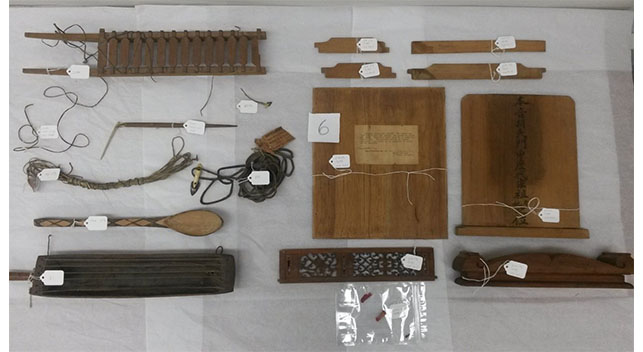
A “Native Fiddle” and the Dangers of Collection Ignorance
“Native fiddle” located in the bottom left of the image. Photograph taken by Remi Alie
The administrators of Huron University’s Missionary Museum often put forth generic information about the artifacts in their collection. These generic records still form much of the information tied to the Huron Missionary Museum. The presence of an artifact described only as a “six string Native Fiddle,” represents the potential danger of repatriating artifacts without conducting proper research. The third post in this blog series discusses Naamiwan’s Drum: The Story of a Contested Repatriation of Anishinaabe Artefacts by Maureen Matthews, the Curator of Cultural Anthropology at the Manitoba Museum. In this work, Matthews brings forth the case of Naamiwan’s Drum to demonstrate the potential harm of repatriation while neglecting to conduct proper research on the meaning of objects to their source communities. To the Pauingassi Ojibwe community from which Naamiwan’s Drum originates, the instrument carries special significance because of its connection to Naamiwan, who was its first owner. The Pauingassi believe objects like Naamiwan’s Drum are animate and encapsulate a spiritual presence from their owner. [1] Conducting proper research is therefore an essential aspect of the repatriation process to ensure the return of objects to the proper communities. The collection inventory used in this post comes from the Principal of Huron College during the Huron Missionary Museum’s Operation. From 1911-1941, Principal C.C. Waller created an inventory of the Huron Missionary Museum Collection. Remi Alie, a student at Huron College, transcribed this inventory as part of a project in the class “HIST 3801: The Historian’s Craft” at Huron University College. According to Principal Waller’s collection inventory, the artifact located in the bottom left corner of Figure 1 is a six-string “Native Fiddle” from German East Africa, donated by T. B. R. Westgate. However, the inventory mentions nothing of the source community and the potential meanings associated with this object. This lack of specificity means that Huron University knows very little about objects like the “Native fiddle” because it has few other collection resources to consult. We learned in the third post of this blog series that different cultures can attach different meanings to objects. For example, the Pauingassi Ojibwe people from which Naamiwan’s Drum descended, view the object as animate and they thereby have much personal connection it. Administrators at the University of Winnipeg assumed that the Pauingassi Ojibwe no longer practiced traditional Ojibwe beliefs and thereby incorrectly interpreted the Pauingassi’s adaptation of Christian values as a form of distancing from the traditional aspects of their culture. In University’s view, this supposed transition away from traditional values justified the repatriation of the drum and other objects to another Ojibwe community. This decision upset the Pauingassi Ojibwe people who had no idea that these objects (of massive significance to them) would transfer to another community. [2] The University of Winnipeg caused great harm to the Pauingassi Ojibwe by repatriating the objects to another community. If Huron University chooses to explore repatriation without attributing proper research, the college risks repeating the mistakes of the University of Winnipeg. Expansive research plays an important role in improving knowledge of collections. The Waller inventory provides little information about the fiddle found in this image. In this case, it is important that we further explore this fiddle’s history. T. B. R. Westgate (who featured more extensively in the fourth post of this blog series) was a Huron alumnus who partnered with the German East African regime during his time as a missionary in East Africa. This regime killed hundreds of thousands of Indigenous East African people during its rule. [3] It is from this period that Westgate collected objects like this fiddle. This knowledge of Westgate’s colonial influence and collaboration with German East Africa changes the nature of owning or repatriating such objects. Huron now has significant reason to question the ethical collection of objects in its collection. We must ask ourselves: under what conditions did Westgate procure this fiddle? If Huron were to repatriate this object, this question needs to be front and centre. Answering it will help the college respond more appropriately if the source community accepts repatriation. With the knowledge that objects carry different meanings to different cultures, the lack of information known about the “Native fiddle” means Huron could commit grave injustices toward the source community of this object. Committing further time and resources through the practice of practical relativism to researching objects in the collection, like what has begun with this project, will give far more context to the objects. This will allow for more proper coordination and communication with potential source communities as Huron will be better informed of the community’s history and relationship with the object.Notes
[1] James Leonard Giblin and Jamie Monson, Maji Maji: Lifting the Fog of War (Leiden, The Netherlands: Brill, 2010), 1. [2] Matthews, Naamiwan’s Drum, 177-178. [3] Maureen Matthews, Naamiwan’s Drum: The Story of a Contested Repatriation of Anishinaabe Artefacts (Toronto, ON: University of Toronto Press, 2016), 66.